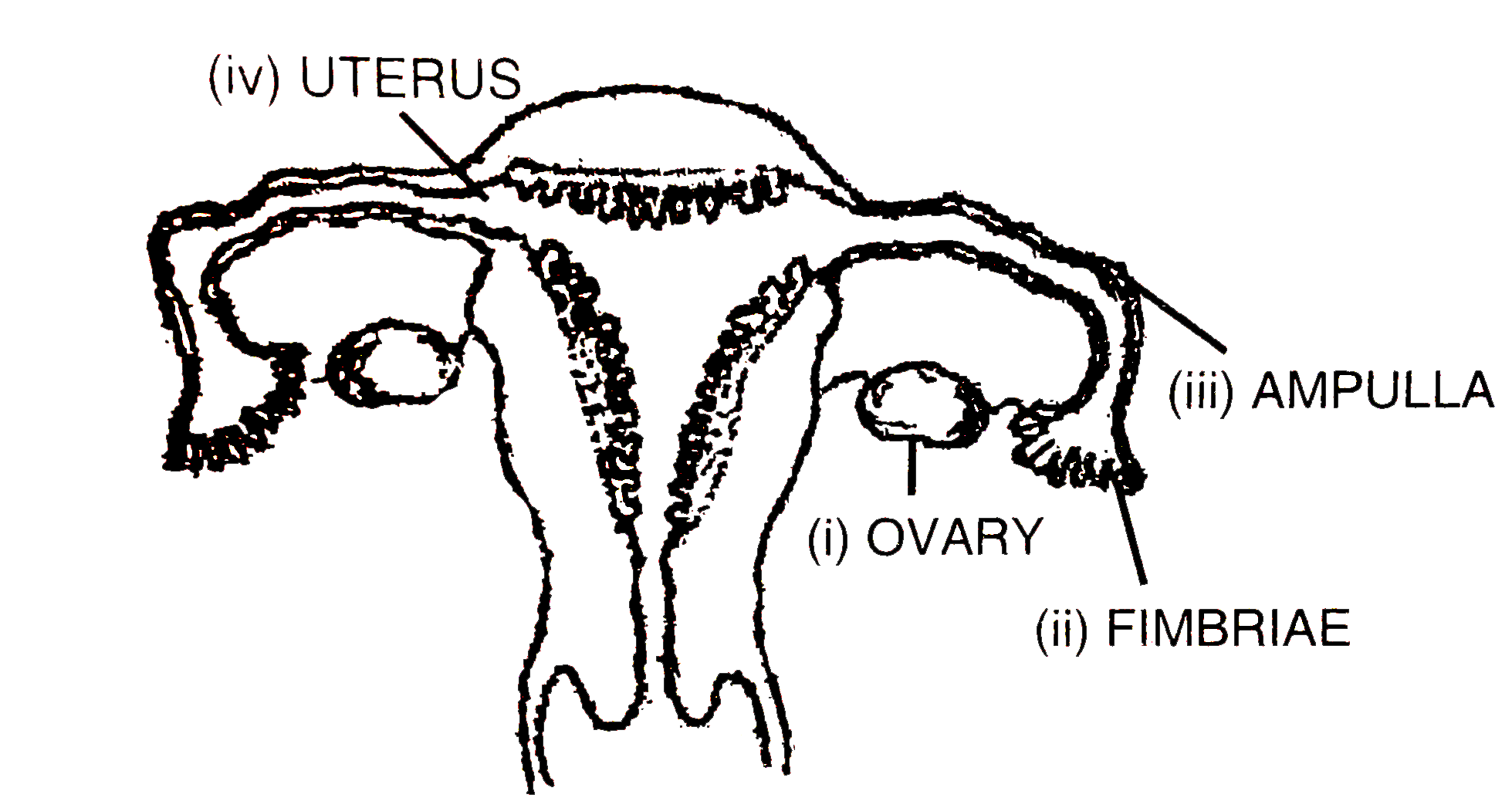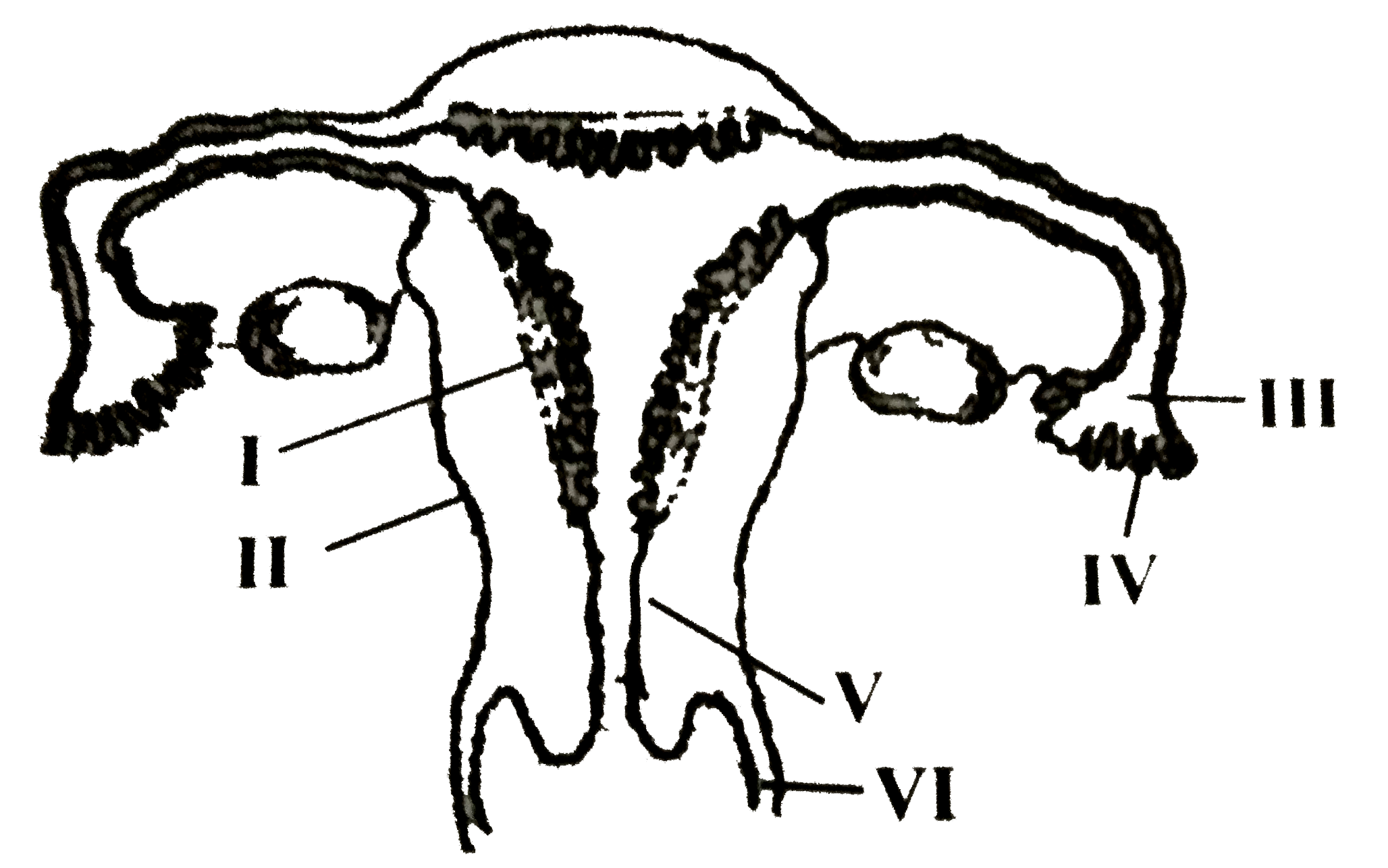(a) Draw a diagrammatic sectional view of the female reproductive system of human and label the parts
(i) where the secondary oocytes develop
(ii) which helps in collection of ovum after ovulation
(iii) where fertilization occurs
(iv) where implantation of embryo occurs.
(b) Explain the role of pituitary and the ovarian hormones in menstrual cycle in human females.

(b) Role of pituitary hormones in menstrual cycle. The secretion of gonadotropins (LH and FSH) stimulates follicular development as well as secretion of estrogens by the growing ovarian follicles. Both LH and FSH attain a peak level in the middle of the cycle (about 14 day). Rapid secretion of LH leading to its maximum level during the mid-cycle called LH surge induces rupture of Graafian follicle and thereby the release of ovum (ovulation) The ovulation is followed by the luteal phase during which the remaining parts of Graafian follicle transform as the corpus luteum. LH maintains the corpus luteum as well as secretion of progesterone by the corpus luteum.
Topper's Solved these Questions
- REPRODUCTIONBOOK - TRUEMAN BIOLOGYCHAPTER - REPRODUCTIONEXERCISE - SECTION -C
22 Videos
- Protista BOOK - TRUEMAN BIOLOGYCHAPTER - Protista EXERCISE - ASSERTION AND REASON
5 Videos
- Reproduction In OrganismsBOOK - TRUEMAN BIOLOGYCHAPTER - Reproduction In OrganismsEXERCISE - MULTIPLE CHOICE QUESTION
128 Videos
Similar Questions
(a) Draw diagram of female reproductive system of human. Label the following parts:
(1) Site of secondary oocyte development
(2) Structures help in collection of ovum.
(3) Site of fertilization.
(4) Site where implantation of embryo occurs.
(b) Name the hormones secreted by ovary. Also state their functions.
View SolutionDraw a neat diagram of female reproductive system in humans and label the part where:
(a) egg is produced
(b) fertilization occurs
View Solution
Knowledge Check
The given figure depicts a diagrammatic sectional view of the human female reproductive system. Which set of three parts out of I−Vi have been correctly identified?
 A(II) endometrium, (III) infundibulum, (IV) fimbriaeB(III) infundibulum, (IV) fimbriae, (V) cervixC(IV) oviducal funnel, (V)uterus,(VI)cervixD(I) perimetrium, (II) myometrium, (III) Fallopian tube
A(II) endometrium, (III) infundibulum, (IV) fimbriaeB(III) infundibulum, (IV) fimbriae, (V) cervixC(IV) oviducal funnel, (V)uterus,(VI)cervixD(I) perimetrium, (II) myometrium, (III) Fallopian tube
In the human female reproductive system where does fertilization occur?
View SolutionDraw a sectional view of human female reproductive system and label the following parts:
(i) Where the development of egg occurs.
(ii) Where fertilisation takes place.
(iii) Where fertilised eggs get implanted.
(b) Describe the changes the uterus undergoes :
(i) To receive the zygote.
(ii) If zygote is not formed.
View SolutionName the parts of the human female reproductive system where fertilization occurs.
View Solution(a) Draw a sectional view of human female reproductive system and label the part where
(i) eggs develop
(ii) fertilsation take place.
(iii) fertilised egg gets implanted.
(b) Describe, in brief, the changes the uterus undergoes
(i) to receive the zygote.
(ii) if zygote is not formed.
View Solution(a) Draw a diagram of the adult human female reproductive system and label the different :
(i) parts of fallopian tube lt (b) Explain the events during fertilization of an ovum in humans.
View Solution(a) Draw a labelled diagram of the human female reproductive system.
(b) Enumerate the events in the ovary of a human female during
(i) Follicular phase
(ii) Luteal phase of menstrual cycle.
View Solution(a) Draw a diagrammatic sectional view of a mature anatropous ovule and label the following parts in it :
(i) that develops into seed coat.
(ii) that develops into an embryo after fertilization.
(iii) that develops into an endosperm in an albuminous seed.
(iv) through which the pollen tube gains entry into the embryo sac.
(v) that attaches the ovule to the placenta.
(b) Describe the characteristic features of wind pollinated flowers.
View Solution